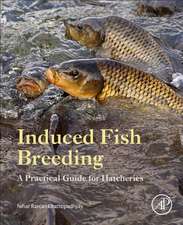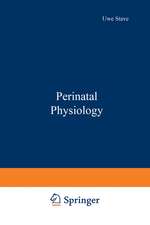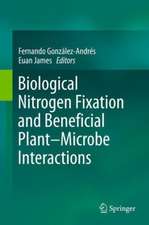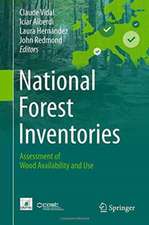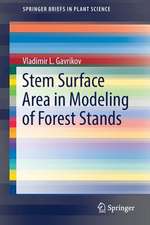In Search of the Physical Basis of Life
Autor Gilbert Lingen Limba Engleză Paperback – 4 oct 2011
Preț: 1419.19 lei
Preț vechi: 1730.72 lei
-18% Nou
Puncte Express: 2129
Preț estimativ în valută:
271.57€ • 284.11$ • 225.59£
271.57€ • 284.11$ • 225.59£
Carte tipărită la comandă
Livrare economică 03-17 aprilie
Preluare comenzi: 021 569.72.76
Specificații
ISBN-13: 9781461296614
ISBN-10: 1461296617
Pagini: 824
Ilustrații: XXX, 792 p.
Dimensiuni: 178 x 254 x 48 mm
Greutate: 1.54 kg
Ediția:Softcover reprint of the original 1st ed. 1984
Editura: Springer Us
Colecția Springer
Locul publicării:New York, NY, United States
ISBN-10: 1461296617
Pagini: 824
Ilustrații: XXX, 792 p.
Dimensiuni: 178 x 254 x 48 mm
Greutate: 1.54 kg
Ediția:Softcover reprint of the original 1st ed. 1984
Editura: Springer Us
Colecția Springer
Locul publicării:New York, NY, United States
Public țintă
ResearchDescriere
It is highly probable that the ability to distinguish between living and nonliving objects was already well developed in early prehuman animals. Cognizance of the difference between these two classes of objects, long a part of human knowledge, led naturally to the division of science into two categories: physics and chemistry on the one hand and biology on the other. So deep was this belief in the separateness of physics and biology that, as late as the early nineteenth century, many biologists still believed in vitalism, according to which living phenomena fall outside the confines of the laws of physics. It was not until the middle of the nineteenth century that Carl Ludwig, Hermann von Helmholz, Emil DuBois-Reymond, and Ernst von Briicke inaugurated a physicochem ical approach to physiology in which it was recognized clearly that one set of laws must govern the properties and behavior of all matter, living and nonliving . . The task of a biologist is like trying to solve a gigantic multidimensional crossword fill in the right physical concepts at the right places. The biologist depends on puzzle: to the maturation of the science of physics much as the crossword solver depends on a large and correct vocabulary. The solver of crossword puzzles needs not just a good vocabulary but a special vocabulary. Words like inee and oke are vitally useful to him but are not part of the vocabulary of an English professor.
Cuprins
I. Opposing Concepts in Cell Physiology: History and Background.- 1. The Early History of Cell Physiology.- 1.1. The Evolution of Physiology as the Physics and Chemistry of Living Phenomena.- 1.2. The Cell Theory.- 1.3. The Discovery of Protoplasm.- 1.4. Colloidal Chemistry and the Concept of Bound Water.- 1.5. Traube’s Semipermeable Copper Ferrocyanide Gel Membrane and the Introduction of the van’t Hoff Equation.- 1.6. Pfeffer’s Membrane Theory.- 1.7. Summary.- 2. Evolution of the Membrane and Bulk Phase Theories.- 2.1. Concepts of the Nature of the Plasma Membrane.- 2.1.1. The Lipoidal Theory of Overton.- 2.1.2. Mosaic Membranes with Pores.- 2.1.3. Membranes with Charged Pores and Selective Ionic Permeability.- 2.1.4. The Paucimolecular Membrane of Davson and Danielli.- 2.2. Cellular Electrical Potentials and Swelling in the Context of the Membrane Theory.- 2.2.1. Early History of Cellular Electrical Potentials.- 2.2.2. Bernstein’s Membrane Theory and the Diffusion Potential.- 2.2.3. The Cremer-Haber-Klemensiewicz Theory for Glass Electrodes.- 2.2.4. Phase Boundary Potentials and the Baur-Beutner Controversy.- 2.2.5. Michaelis’s Theory of the Cation-Permeable Collodion Membrane.- 2.2.6. The Donnan Theory of Membrane Equilibrium.- 2.3. Cellular Ionic Distribution in the Context of the Membrane Theory.- 2.3.1. Boyle and Conway’s Theory of Membrane Potentials, Ionic Distribution, and Swelling’.- 2.4 Early Criticisms of and Experimental Evidence against the Membrane Theory.- 2.5. Inquiries into the Nature of Protoplasm.- 2.5.1. Protoplasm as a Structural Substance.- 2.5.2. Fischer’s Theory of Protoplasm.- 2.5.3. Lepeschkin’s Vitaid Theory.- 2.5.4. Nasonov’s Phase Theory of Permeability and Bioelectric Potentials.- 2.5.5. Bungenberg de Jong’s Concept of Protoplasm as a Coacervate.- 2.6. Early Inquiries into the Physical State of Water and Ions in Living Cells.- 2.6.1. Bound Water.- 2.6.2. Bound K+.- 2.7. Rejection of the Bulk Phase Theories.- 2.7.1. Evidence against the Bulk Phase Theories.- 2.7.2. Evidence against the Concepts of Bound K+ and Bound Water.- 2.8. Summary.- 3. The Emergence of the Steady-State Membrane Pump Concept.- 3.1. Major Developments Providing the Background for the Acceptance of the Membrane Pump Theory.- 3.1.1. The Disproof of the Original Equilibrium Membrane Theory.- 3.1.2. The Concept That the Constituents of Living Beings Are in a State of Dynamic Equilibrium.- 3.1.3. The Hill-Embden Controversy and “A-lactic Acid” Muscle Contraction.- 3.1.4. The High-Energy Phosphate Bond as the Immediate Source of Energy for Biological Work Performance, Including Ionic Pumping.- 3.2. The Postulation of the Na+ Pump.- 3.3. Arguments and Evidence in Support of the Na+ Pump Theory.- 3.3.1. The Dependence of Ionic Distribution on Continued Metabolic Activities and Normal Temperature.- 3.3.2. The Energy Requirement of the Na+ Pump Appears to Be Adequately Met by Cell Metabolism.- 3.3.3. Active Solute Transport by Epithelial Tissues and Giant Algal Cells.- 3.4. The Further Development of the Membrane Theory of Cellular Electrical Potential in the Context of the Membrane Pump Theory: The Ionic Theory of Hodgkin, Katz, and Huxley.- 3.4.1. The Hodgkin-Katz-Goldman Equation.- 3.4.2. The Hodgkin-Huxley Theory of the Action Potential.- 3.4.3. The Hodgkin-Huxley Theory of Permeability Changes during the Action Potential.- 3.4.4. Experimental Confirmation of the Membrane Theory of the Resting and Action Potentials.- 3.5. Summary.- 4. The Reemergence of the Bulk Phase Theories.- 4.1. Kamnev’s Study of Sugar Distribution in Frog Muscle.- 4.2. Troshin’s Sorption Theory.- 4.2.1. Osmotic Behavior of Living Cells.- 4.2.2. Cells as Colloidal Coacervates.- 4.2.3. Solute Exclusion and Accumulation.- 4.3. Rekindled Doubts about the Revised Membrane Pump Theory.- 4.3.1. Discovery of the Non-Donnan Distribution of Many Permeant Substances.- 4.3.2. Reinvestigation of the Question of Whether or Not Cells Have Enough Energy to Operate the Postulated Na+ Pump.- 4.4. Ling’s Fixed-Charge Hypothesis.- 4.4.1. A New Molecular Mechanism for the Selective Accumulation of K+ over Na+ in Living Cells.- 4.4.2. Some Distinctive Features of Ling’s Fixed-Charge Hypothesis.- 4.5. Molecular Mechanisms of Selective Ionic Permeability.- 4.5.1. The Membrane Carrier Model.- 4.5.2. Ling’s Fixed-Charge Hypothesis.- 4.6. The Surface Adsorption Theory of the Cellular Resting Potential.- 4.6.1. Three Historical Models: Glass, Oil, and Collodion.- 4.6.2. The Surface Adsorption Theory of Cellular Electrical Potentials.- 4.7. Summary.- 5. Experimental Tests of the Alternative Theories.- 5.1. Evidence Supporting the Membrane Pump Theory.- 5.1.1. Full Ionic Dissociation of K+ Salts in Water at Ionic Strengths Similar to Those in Living Cells.- 5.1.2. High Mobility of K+ in Living Cells.- 5.1.3. High K+ Activity in Living Cells.- 5.1.4. Genetic Control of Permeases or Sugar Pumps.- 5.1.5. Na+,K+-Activated ATPase as the Na+ Pump.- 5.1.6. “High Energy” Contained in the Phosphate Bonds of ATP Provides the Immediate Source of Energy for Na+ Pumping..- 5.2. Evidence against the Pump Hypothesis.- 5.2.1. There Is Not Enough Energy to Operate the Na+ Pump.- 5.2.2. Reassessment of the High Energy of the “High-Energy Phosphate Bond”.- 5.2.3. Failure to Demonstrate Selective K+ Accumulation and Na+ Exclusion by a Cytoplasm-Free Squid Axon Membrane Sac.- 5.2.4. Failure to Prove Selective Ion Pumping in Membrane Vesicles.- 5.2.5. Studies of the Red Cell Ghost.- 5.2.6. Ouabain-Sensitive Selective Accumulation of K+ over Na+ in an Effectively Membrane (Pump)-less Open-Ended Muscle Cell (EMOC) Preparation.- 5.3. Summary.- II. The Association-Induction Hypothesis.- 6. The Association-Induction Hypothesis I. Association of Ions and Water with Macromolecules.- 6.1. The Living State.- 6.1.1. The General Concept of a High-Energy Resting State.- 6.1.2. The Major Components of Living Systems.- 6.1.3. Protoplasm and the Living State.- 6.2. Association of Ions.- 6.2.1. Enhanced Counterion Association in a Fixed-Charge System.- 6.2.2. The Theory of Selective Ionic Adsorption and Its Variation with the Electron Density or c- Value of the Fixed Anionic Sites.- 6.2.3. Reversal of Ionic Selectivity Ratios: Comparison of Theory with Experiment in Ion Exchange Resins.- 6.2.4. Generalized Relations between c-Value and Adsorption Constants.- 6.2.5. Salt Linkages, c-Value, and the in Vitro Demonstration of Selective Na+ and K+ Adsorption on Isolated Proteins.- 6.3. Association of Water.- 6.3.1. Historical Background.- 6.3.2. The Polarized Multilayer Theory of Cell Water.- 6.3.3. Theory of Solute Exclusion from Water Existing in the State of Polarized Multilayers.- 6.3.4. in Vitro Experimental Testing of the Polarized Multilayer Theory of Cell Water in Model Systems.- 6.4. Summary.- 7. The Association-Induction Hypothesis II. The Inductive Effect and the Control of Physiological Activities.- 7.1. The Inductive Effect.- 7.1.1. Early Theories of the Molecular Inductive Effect.- 7.1.2. Chiang and Tai’s Theory: A Quantitative Relation between Molecular Structure and Chemical Reactivity.- 7.1.3. Functional Groups Affected by the Inductive Effect.- 7.2. The Direct F-Effect and the Molecular Mechanisms of Physiological Control.- 7.2.1. Association of Protons and Adsorption of Cations.- 7.2.2. Changes in H-Bonding.- 7.3. Modulation and Control of Physiological Activities.- 7.3.1. The One-Receptor-Site System as a Model for Competitive Interaction.- 7.3.2. The Two-Receptor-Site System as a Model for Noncompetitive Facilitation and Inhibition.- 7.4. Cooperativity: Molecular Basis for Controlled and Coordinated Physiological Activities.- 7.4.1. The Indirect F-Effect: The Propagated Inductive Effect.- 7.4.2. The Yang-Ling Cooperative Adsorption Isotherm.- 7.4.3. The Control of Shifts between Discrete Cooperative States by the Adsorption and Desorption of Cardinal Adsorbents.- 7.4.4. An Analysis of the Theoretical Model of Controlled Cooperative Interaction.- 7.5. Summary.- 8. The Physical State of K+ and Na+ in Living Cells.- 8.1. A Reassessment of the Critical Experiments of Hill and Kupalov…..- 8.2. Experimental Proof That the Bulk of Muscle K+ Is in an Adsorbed State.- 8.2.1. Early Work on Localization of K+.- 8.2.2. Electron Microscopic Demonstration of Localization of K+.- 8.2.3. Autoradiographic Demonstration of Localization of K+.- 8.2.4. Energy-Dispersive X-Ray Microanalysis.- 8.2.5. Laser Microprobe Mass Spectrometric Analysis.- 8.2.6. Implications of the Adsorbed State of K+ in Muscle Cells….- 8.3. X-Ray Absorption Edge Fine Structure of K+ in Frog Erythrocytes.- 8.4. Secondary Evidence for K+ Adsorption in Living Cells.- 8.4.1. K+ Mobility in Living Cells.- 8.4.2. K+ Activity in Living Cells Measured with an Ion-Specific Microelectrode.- 8.4.3. NMR Relaxation Times of 23Na+ and 39K+ in Living Cells.- 8.5. Summary.- 9. The Physical State of Water in Living Cells.- 9.1. Introduction.- 9.2. Solvent Properties.- 9.2.1. Inanimate Models.- 9.2.2. Biopolymers and Viruses.- 9.2.3. Living Cells.- 9.3. Freezing Points.- 9.3.1. Theoretical Expectations.- 9.3.2. Behavior of Models.- 9.3.3. Freezing Pattern of Living Cells.- 9.4. Vapor Sorption Isotherms.- 9.5. Infrared and Raman Spectra.- 9.6. Dielectric Dispersion.- 9.6.1. Model Systems.- 9.6.2. Living Cells.- 9.7. NMR Relaxation Times of Water Protons and Other Nuclei.- 9.7.1. NMR Theories.- 9.7.2. NMR Studies of Water in Solutions of Native Globular Proteins.- 9.7.3. NMR Studies of Water in Living Cells.- 9.7.4. Concluding Remarks on the Current Status of NMR Studies.- 9.8. Quasielastic Neutron Scattering.- 9.9. Summary.- 10. ATP and the Source of Energy for Biological Work Performance.- 10.1. The General Question of the Energization of Biological Work.- 10.2. The Heat Engine Theory.- 10.3. The High-Energy Phosphate Bond Concept.- 10.4. The Energy Source for Biological Work Performance According to the AI Hypothesis.- 10.4.1. The Immediate Source of Energy for Biological Work Performance.- 10.4.2. The Source of Energy for Cyclic Work Performance.- 10.5. Summary.- III. Applications of the Association-Induction Hypothesis to Traditional Problems in Cell Physiology.- 11. Selective Distribution of Ions, Sugars, and Free Amino Acids.- 11.1. The General Theory of Solute Distribution.- 11.1.1. Equation Describing Solute Distribution.- 11.1.2. Control of Solute Distribution by Cardinal Adsorbents.- 11.1.3. The Effect of Temperature on Solute Distribution.- 11.2. Experimental Testing of the Theory.- 11.2.1. Basic Patterns of Solute Distribution: Free and Adsorbed Fractions.- 11.2.2. Cooperativity in Solute Adsorption.- 11.2.3. Effect of Temperature on Solute Distribution.- 11.2.4. Control of Solute Distribution by Cardinal Adsorbents.- 11.3. Summary.- 12. Permeability.- 12.1. Evidence against the Conventional Lipoidal Membrane Theory.- 12.1.1. K+-Specific Ionophores Do Not Increase the Permeability of Living Cell Membranes to K+.- 12.1.2. There Is Not Enough Lipid in Many Membranes to Provide a Continuous Bilayer.- 12.1.3. Removal of Membrane Lipids from the Liver Mitochondrion Inner Membrane Does Not Alter the Trilayer Structure.- 12.2. What Is the Rate-Limiting Step for the Entry of Water into Living Cells?.- 12.3. Polarized Water as the Semipermeable, Selective Permeability Barrier.- 12.4. Permeability of Cells to Ions.- 12.4.1. Influx of Ions.- 12.4.2. Efflux of Ions.- 12.5. Sugar Permeation and Its Control by Insulin.- 12.6. Amino Acid Permeation and Its Dependence on External Na+.- 12.6.1. The Saturable and Nonsaturable Fractions in the Uptake and Exodus of Amino Acids.- 12.6.2. Permeation of Glycine and Other Neutral Amino Acids into Ehrlich Ascites Cells.- 12.6.3. The Saturable Fraction.- 12.7. Surface Protein Adsorption Sites as the Seat of the Selective Adsorption-Desorption Route for Entry of Amino Acids.- 12.8. Summary.- 13. Swelling, Shrinkage, and Volume Control of Living Cells.- 13.1. The Refutation of the Membrane Theory of Cell Volume Regulation.- 13.2. Polarized Water in Lieu of Free Intracellular K+ in the Maintenance of Osmotic Pressure of Living Cells.- 13.3. What Does the Vapor Sorption Isotherm Tell Us about the Osmotic Behavior of Living Cells?.- 13.4. Swelling of Living Cells in Isotonic KC1 and Other Salt Solutions.- 13.5. The Variable Number of K+, Rb+, and Cs+ Adsorption Sites: The Role of Salt Linkages.- 13.6. The Mechanism of Cell Swelling Caused by the Depletion of ATP and the Role of NaCl in the Medium.- 13.7. Classification of Cell and Tissue Swelling.- 13.8. Summary 461.- 14. Electrical Potentials.- 14.1. Evidence against the Membrane Theory of Cellular Electrical Potentials.- 14.1.1. The Indifference of Resting Potential in Frog Muscle to External Cl- Concentration.- 14.1.2. Do the Resting and Action Potentials Depend on the Intracellular Concentrations of K+ and Na+?.- 14.1.3. The Electrogenic Na+ Pump Hypothesis.- 14.1.4. All-or-None Opening and Closing of Na+ and K+ Gates.- 14.1.5. The Independence Principle.- 14.1.6. The Significance of the Demonstration of the Localization of the Bulk of Intracellular K+ in Frog Muscle.- 14.2. Evidence for the Surface Adsorption Theory of Cellular Resting Potentials.- 14.2.1. Collodion-Coated Glass Electrode.- 14.2.2. Colacicco’s Experiment on Oil Membranes.- 14.2.3. Edelmann’s Experiment on Guinea Pig Heart Trabecular Muscle.- 14.3. Experimental Observations Not Explicable by the Membrane Theory but in Harmony with the Surface Adsorption Theory.- 14.3.1. The Adsorbed State of Cell K+.- 14.3.2. The Lack of a Relation between External Cl- and ?.- 14.3.3. The Contradictory Reports on the Relation between ? and Intracellular K+.- 14.4. The Molecular Mechanism of the Resting and Action Potentials 477.- 14.4.1. The New Equation for the Cellular Resting Potential.- 14.4.2. The Control of the Resting Potential by Cardinal Adsorbents According to the AI Hypothesis.- 14.4.3. Changes of the Resting Potential of Toad Oocytes during the Maturation Process.- 14.4.4. Effect of Mechanical Puncturing of the Cell Surface on Oocyte Activation 488.- 14.5. Molecular Events Underlying Excitation.- 14.5.1. Basic Molecular Structure and Properties of the Cell Surface of Muscle and Nerve According to the AI Hypothesis.- 14.5.2. The Molecular Basis of the Sudden, Transient Permeability Increase during Excitation.- 14.6. Summary.- IV. A Reevaluation of Current Concepts in Physiology and Biochemistry.- 15. Oxidative Phosphorylation, ATP Synthesis, and Other Aspects of Mitochondrial Physiology.- 15.1. The Central Role of ATP in Biological Work Performance.- 15.2. The Sources of ATP.- 15.2.1. Creatine Phosphate and Arginine Phosphate.- 15.2.2. Glycolysis or Fermentation.- 15.2.3. Respiratory Chain.- 15.3. Theories of the Mechanism of Oxidative Phosphorylation and Their Critiques.- 15.3.1. The Chemical Coupling Hypothesis.- 15.3.2. The Conformation Coupling Hypothesis.- 15.3.3. The Chemiosmotic Hypothesis.- 15.4. A Tentative Model of the Inductive-Associative Coupling Mechanism for Electron Transport and Oxidative Phosphorylation.- 15.4.1. The Coupling Mechanism.- 12.4.2. Comparison with Model Systems.- 15.5. New Interpretations of Observations in Mitochondrial Physiology.- 15.5.1. Swelling and Shrinkage.- 15.5.2. “Transport” of ATP.- 15.5.3. Uncouplers, Ionophores, Ca2+, Mg2+, ATP, and Other Cardinal Adsorbents.- 15.5.4. Synchronous Oscillatory Changes in Properties of Mitochondria.- 15.6. Summary.- 16. Muscle Contraction and Related Phenomena.- 16.1. Early Theories of Muscle Contraction.- 16.1.1. Engelmann’s Heat Engine Theory.- 16.1.2. The Osmotic Theories of McDougall and MacDonald.- 16.1.3. The Lactic Acid Theory.- 16.1.4. The Engelhardt-Ljubimova Theory.- 16.1.5. The Actin-Myosin Association Theory of Szent-Gyorgyi.- 16.1.6. The Active Relaxation Theory.- 16.1.7. The Electrostatic Extension-Entropic Contraction Theory.- 16.1.8. The Earlier Association-Induction Model.- 16.2. Current Views of the Mechanism of Muscle Contraction.- 16.2.1. The Sliding Filament Theories.- 16.2.2. The Kinetics of the Unregulated Actin-Myosin-ATP System.- 16.2.3. The Control Mechanism.- 16.2.4. Other Recent Theories of Muscle Contraction.- 16.3. Critique of the Sliding Filament Model.- 16.3.1. The Energy Problem.- 16.3.2. The Number, Duration, and Synchronization of Cycles of Cross-Bridge Formation and Breakage.- 16.3.3. What Keeps the Filaments from Tangling Up?.- 16.3.4. Why Should the Bulk of Water in the I Bands Move with the Telescoping Thin Filaments?.- 16.4. A Tentative Model of Muscle (and Nonmuscle Cell) Contraction: An Updated Theory According to the AI Hypothesis.- 16.4.1. The Resting, Relaxed Muscle.- 16.4.2. Contraction.- 16.4.3. Relaxation.- 16.5. Agreements and Disagreements with Relevant Existing Knowledge.- 16.5.1. Electron Microscopic and X-Ray Diffraction Evidence of the Continuing Existence of Thin Filaments.- 16.5.2. A Key Role of Cell Water in Muscle Contraction.- 16.5.3. A Mechanism That Prevents the Filaments from Tangling Up.- 16.5.4. A Key Role of K+ Adsorption and Desorption in Muscle Contraction.- 16.5.5. The Source of Energy and Force in Muscle Contraction.- 16.6. Summary.- 17. Active Transport across Intestinal Epithelia and Other Bifacial Cell Systems.- 17.1. Unifacial and Bifacial Cells.- 17.2. Concepts of Active Solute Transport Based on the Membrane Pump Theory.- 17.2.1. The “Two-Membrane Theory” of Koefoed-Johnson and Ussing.- 17.2.2. The Standing Osmotic Gradient Theory of Diamond and Bossert.- 17.2.3. The Pericellular Pump Theory of Cereijido and Rotunno.- 17.2.4. The Na+ Gradient Hypothesis of Sugar and Amino Acid Transport.- 17.3. Cooperative Adsorption-Desorption Model of Active Transport across Epithelia and other Bifacial Cell Systems.- 17.4. Application of the Model to Experimental Findings.- 17.4.1. Cyclic Changes of Adsorption-Desorption as the Basis for Active Transport.- 17.4.2. Location of the Pumping Mechanism.- 17.4.3. The Source of Energy for Active Transport.- 17.4.4. Coupling of Ion and Water Transport.- 17.4.5. The Relation between “Homocellular” Regulation of Cell K+ and Na+ Composition and “Homoepithelial” Na+ Transport.- 17.4.6. Coupling of Na+ Transport with Sugar and Amino Acid Transport.- 17.5. Summary.- V. A Tentative Approach to Some Unsolved Problems in Biology and Medicine.- 18. The Control of Protein Synthesis.- 18.1. Transcription and Translation in Prokaryotes.- 18.1.1. The lac Operon and the Control of Gene Transcription.- 18.1.2. The Role of K+, Na+, Glycerol, and DMSO in DNA Transcription.- 18.1.3. The Role of K+ in mRNA Translation.- 18.2. The Control of Gene Function in Eukaryotes.- 18.2.1. Gene Transcription.- 18.2.2. mRNA Translation and Protein Synthesis.- 18.3. Summary.- 19. Growth and Differentiation.- 19.1. Mosaic and Regulative Eggs.- 19.2. Maturation of Amphibian Eggs.- 19.2.1. Ca2+ and the Depolarization of the Electrical Potential.- 19.2.2. Maturation-Promoting Factor.- 19.2.3. A Key Role of Adsorbed Na+ in the Control of Maturation.- 19.2.4. An Attempt to Provide a Consistent Theoretical Framework for Future Investigation.- 19.2.5. Other Cytoplasmic Factors in Maturing Oocytes: Cytostatic Factor and Chromosome-Condensing Activity.- 19.3. Fertilization (or Activation) of Sea Urchin Eggs.- 19.3.1. Alteration of Surface Proteins Accompanying Activation.- 19.3.2. Electrical Potential Changes Accompanying Activation.- 19.3.3. Ca2+ Release Accompanying Activation.- 19.3.4. Requirement of External Na+ in Egg Fertilization.- 19.4. Differentiation.- 19.4.1. Brief Historical Sketch.- 19.4.2. Classical Transplantation Experiments of Spemann and Mangold.- 19.4.3. In Search of the Evocator.- 19.4.4. Barth and Barth’s Experiments and Theory of Differentiation.- 19.4.5. Landstrom and Lavtrup’s Work on Differentiation.- 19.4.6. Concluding Remarks on Differentiation.- 19.5. The Cell Cycle.- 19.5.1. The Transition Probability Model.- 19.5.2. The Control of Entry into the C Phase.- 19.5.3. Control of Chromosome Condensation.- 19.5.4. The Promotion of Differentiation of Enucleated Eggs by Nuclear Transplantation.- 19.6. The Stem Cells: “Immortal” Queen Bees of the Society of Renewing Cells.- 19.7. Some Molecular Mechanisms According to the AI Hypothesis.- 19.7.1. Migration of Proteins (and RNA) between the Nucleus and the Cytoplasm.- 19.7.2. Nuclear Swelling during DNA Replication.- 19.8. Amphibian Metamorphosis.- 19.8.1. Thyroid Hormones.- 19.8.2. Prolactin.- 19.9. Summary.- 20. Cancer.- 20.1. General Theories of Cancer.- 20.1.1. The Somatic Mutation Theory: Historical Background.- 20.1.2. Dramatic Recent Confirmation of the Somatic Mutation Theory.- 20.1.3. The Maldifferentiation Theory.- 20.2. Physiological Theories of Cancer.- 20.2.1. Szent-Gyorgyi’s Theory of Cancer.- 20.2.2. Cone’s Theory of Cancer.- 20.3. What Distinguishes Cancer from Normal Tissues?.- 20.3.1. The Morphological Generalization.- 20.3.2. The Warburg Generalization.- 20.3.3. The Greenstein Generalization.- 20.3.4. The Roberts-Frankel Generalization.- 20.3.5. The Damadian Generalization.- 20.3.6. The Ling-Murphy Generalization.- 20.4. Another Apparent Paradox and the Bright Future of Cancer Research.- Appendixes.- A. Nuclear Magnetic Resonance Spectroscopy.- A.1. NMR Relaxation Time, Tx.- A.2. Proton Resonance Spectrum, Linewidth, and T2.- A.2.1. Chemical Shift.- A.2.2. Linewidth and T2.- A.3. The Relation of Tx and T2 to the Rotational Correlation Time, Tc.- A.4. Orientation-Dependent Doublet Structure on NMR Spectral Line Shape.- B. Infrared and Raman Spectra.- References.- Abbreviations.- Notation List.

